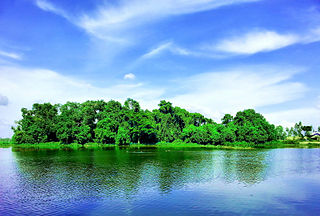Sahebganj is a scenic town and a port city with the serene Ganga and sturdy hills in the Sahibganj subdivision of the Sahebganj district of Jharkhand state, India. It serves as headquarters for Sahibganj District, Sahibganj subdivision and Sahibganj. It is located on the north-east of Jharkhand and situated on the banks of Ganges. 17th May is the Foundation Day of the District, when Rajmahal and Pakur subdivisions of old Santhal Pargana district were carved out to form Sahibganj district.
Budhana is a town, block, tehsil, nagar panchayat, and one of the constituencies of the Uttar Pradesh Legislative Assembly in Muzaffarnagar district in Uttar Pradesh, India.

Mirpur is an upazila of Kushtia District in the Division of Khulna, Bangladesh. Mirpur Thana was formed in 1885 and it was turned into an upazila in 1983.

Ghoraghat is an upazila of Dinajpur District in the Division of Rangpur, Bangladesh.

Khetlal is an upazila of Joypurhat District in the Division of Rajshahi, Bangladesh. Khetlal Thana was formed in 1847 and it was turned into an upazila on 3 July 1983. Khetlal Municipality was declared on 9 December 2010.

The Berar Subah was one of the Subahs of the Mughal Empire, the first to be added to the original twelve, in Dakhin from 1596 to 1724. It bordered Golconda, Ahmandagar, Kandesh and Malwa subahs as well as the independent and tributary chiefdoms to the east.
Mayureswar is a village and gram panchayat in Mayureswar II CD Block in Rampurhat subdivision of Birbhum district in the Indian state of West Bengal.

Sitpur is a city and union council in Tehsil Alipur of Muzaffargarh District in south Punjab, Pakistan. In this city, there is a famous Tomb of Tahir Khan Nahar. Its architecture resembles that of the Multan Tombs, but it is smaller in size compared to them. The Government High School of Seetpur was established by the British during the British Raj. Agriculture is the mainstay of the area's economy.
Borio is a community development block that forms an administrative division in the Sahibganj subdivision of the Sahibganj district, Jharkhand state, India.
Barhait is a community development block that forms an administrative division in the Sahibganj subdivision of the Sahibganj district, Jharkhand state, India.
Taljhari is a community development block that forms an administrative division in the Rajmahal subdivision of the Sahibganj district, Jharkhand state, India.
Rajmahal is a community development block that forms an administrative division in the Rajmahal subdivision of the Sahibganj district, Jharkhand state, India.
Udhwa is a community development block that forms an administrative division in the Rajmahal subdivision of the Sahibganj district, Jharkhand state, India.
Pathna is a community development block that forms an administrative division in the Rajmahal subdivision of the Sahibganj district, Jharkhand state, India.
Ujalpur is a village and post office in Kutubpur union in Meherpur Sadar Upazila of Meherpur, Khulna, Bangladesh. It is the birthplace of Bangladeshi cricketer Imrul Kayes.

Kahinjar is a village in Sareni block of Rae Bareli district, Uttar Pradesh, India. It is located 20 km from Lalganj, the tehsil headquarters. Kahinjar historically served as the headquarters of a mahal since at least the time of Akbar, before being merged into the pargana of Sareni under the Nawabs of Awadh. As of 2011, Kahinjar has a population of 2,099 people, in 354 households. It has one primary school and no healthcare facilities. It belongs to the nyaya panchayat of Rasulpur.
Jhaudia Union is a union parishad situated at Kushtia Sadar Upazila, in Kushtia District, Khulna Division of Bangladesh. The union has an area of 69.20 square kilometres (26.72 sq mi) and as of 2001 had a population of 25,772. There are 11 villages and 7 mouzas in the union.
Qubāzpūr was a town and pargana in western Bengal during the time of the Mughal Empire; the pargana at least also continued to exist under the British Raj. Its exact location is unknown, but its approximate location was in present-day Purba Bardhaman district, somewhere between Samudragarh and Katwa.
Salimabad is a village in Jamalpur block of Purba Bardhaman district, West Bengal, India. It is located on the east bank of the Damodar river, about 20 miles (32 km) south of the city of Bardhaman. Historically known as Sulaimanabad, it was the capital of a sarkar of Mughal Bengal. Today, the primary economic activities in the village are growing rice and producing cloth. As of 2011, Salimabad has a population of 5,491, in 1,282 households.
Sauj is a village in Karhal block of Mainpuri district, Uttar Pradesh. An old village going back at least as far as the late 1500s, Sauj was historically the seat of a pargana until 1840. It occupies a very large area and consists of many distinct hamlets besides the main site. As of 2011, Sauj has a population of 7,957, in 1,318 households.







